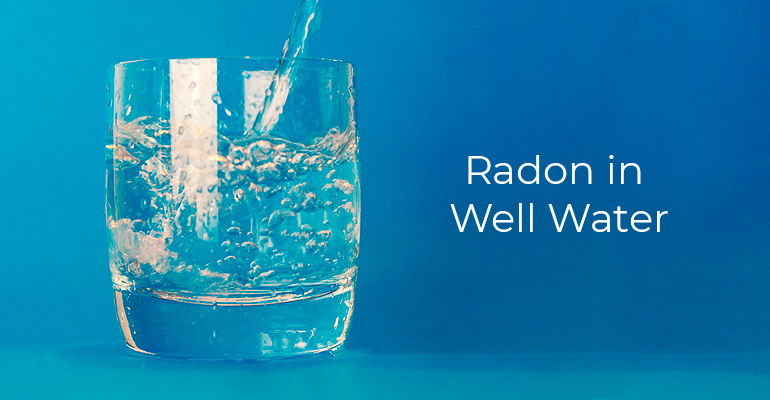Radon in Well Water

What is Radon?
Radon comes from the natural decay of uranium. Uranium is an element that can be found in almost all soils, and also in rocks and water. When the radioactive material in soil or rock decays, it produces radon gas. The radioactive decay of uranium is a slow process that happens over extremely long periods of time. Radon gas then rises towards the ground surface and becomes part of the air and water-filled pores in the soil. Over time, the soil will release the radon gas directly into the atmosphere. The groundwater can also carry the radon away from its original location where it was produced from the soil and rocks. Unfortunately, some water wells are drilled into sources of naturally occurring radon in groundwater. As many as 1 out of every 3 homes have elevated radon levels in some USA States!
Why is Radon in Drinking Water a Health Concern?
Radon is a radioactive gas that causes cancer. You cannot see, smell, nor taste radon in air or water. Breathing radon in indoor air can cause lung cancer. Radon gas decays into radioactive particles that can get trapped in your lungs when you breathe air that has radon. These radioactive particles release small amounts of energy as they continue to break down over time. This damages lung tissue and increases your chances of getting lung cancer.
The United States Surgeon General’s Office and the Environmental Protection Agency (EPA) have estimated that as many as 20,000 lung cancer deaths each year are caused each by radon. This fact makes radon the second leading cause of lung cancer (cigarette smoking is the #1 cause of lung cancer). If you smoke cigarettes and your home has high radon levels, then your risk of lung cancer is especially high! The health care costs in the United States are estimated to be over $2 billion per year due to lung cancer caused by radon! That estimate includes both direct and indirect health care costs. (Based on National Cancer Institute statistics of 14,400 annual radon lung cancer deaths – Oster, Colditz & Kelley, 1984).
It is estimated that only about 2% of radon in the air actually comes from water that has radon in it. Even though this percentage is small, it still increases the existing levels of air radon in the home. Moreover, some amount of radon stays in the water when it flows from the faucets, tubs, showers, etc.. Drinking water that has radon in it will increase your risk of developing cancer in your internal organs, mainly stomach cancer. Based on a National Academy of Science report, the EPA estimates that radon in drinking water causes about 168 cancer deaths per year: 89% from lung cancer caused by breathing radon released to the indoor air from water, and 11% from stomach cancer caused by consuming water containing radon.
Find out if your drinking water is safe.
What is the Source of Radon in my Home?
The radon levels of the indoor air in your home can come from several sources:
- from the soil and rocks under/near your home
- and/or from your water supply
The radon in your water supply poses both an inhalation risk and an ingestion risk. Research has shown that your risk of lung cancer from breathing radon in air, is much larger than your risk of stomach cancer from swallowing water with radon in it. Most of your risk from radon in water comes from the radon released into the air when water is run from a faucet, tub, shower, laundry, or other household plumbing.
Radon is not a concern in water that comes from lakes, rivers, and reservoirs (called surface water), because that radon is released into the air before it ever arrives at your water plumbing pipes and faucets. High levels of radon in water can occur in ground water sources, such as, private wells or public water supply systems that use ground water (as opposed to surface water). Some public water systems treat their water to reduce radon levels before it is delivered to homes in the local community. If you are concerned that radon may be entering your home through the water, and your water comes from a public water supply, then contact your local municipality and water company.
How do I Remove Radon from my Water?
If you test your private well and have a problem with radon in that water, then it can be fixed. Your home’s water supply can be safely treated in two ways:
- Point-of-Entry treatments can effectively remove radon from the water before it enters your home. Point-of-entry treatments usually have either aeration systems or granular activated carbon (GAC) filters. Both GAC filters and aeration systems have advantages and disadvantages that should be discussed with your State radon office or a water treatment professional.
- Aeration treatment involves spraying water or mixing it with air. Then the air with the radon is vented from the water before the water arrives at the plumbing faucets.
- Granular Activated Carbon treatments filter the water through carbon. The radon will attach to the carbon and leave the water radon free. GAC filters can collect radioactivity and may require a special method of disposal if it is a hazardous waste.
- Point-of-Use treatments can remove radon from your water at the faucets. However, these devices only treat a small portion of the water you use. Point-of-use devices must be installed for all water taps in the home to reduce the risk of breathing radon released into the air from water.
Find out if your drinking water is safe.
What Levels of Radon in Water Should I be Concerned About?
The EPA and many States have recommended drinking water standards for radon. These standards in water range from 300 to 10,000 pCi/L. What is a “picocurie” (pCi)? A pCi is a measure of the rate of radioactive decay of radon. One pCi is one trillionth of a Curie, 0.037 disintegrations per second, or 2.22 disintegrations per minute. For example, with radon air measurements at 4 pCi/L (picocuries per liter, the EPA’s recommended action level), there will be approximately 12,672 radioactive disintegrations in one liter of air during a 24-hour period.
For health reasons you need to periodically do radon tests in your home to determine the levels of air radon and water radon. For more information, call EPA’s Drinking Water Hotline at (800) 426-4791. If your water comes from a private well, you should also contact your State radon office.





